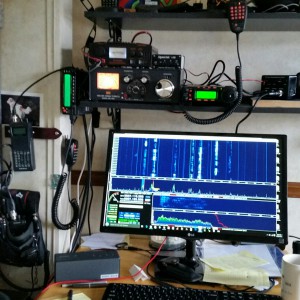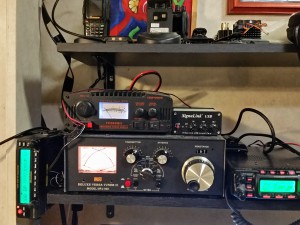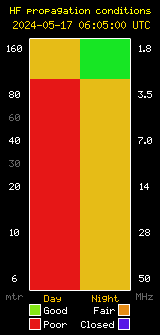Hello All,
I decided to share the details of my HF station here on the SBARC website for a couple of reasons. The primary reason is that maybe someone out there would find my setup useful in building their own station. I am very limited by budget and space so I have to figure out ways of making the most of a little bit of everything. For you HAMS that have $10,000 or more invested in your station, my little station will not compare to your capabilities. Of primary interest in this article is my all-mode HF radio and the Pan-adapter setup.
The first piece of the puzzle came into place about 2 years ago when I purchased the SDRPlay SDR (Software Defined Radio). I got this before I even got my first ham license. The radio itself is a marvelous piece of engineering. It is a receiver that covers the range 100 KHz to 2 GHz continuously. It has a great front end filter bank for anti aliasing. It samples at rates between 2.0 and 10.66 MSPS. It has a 12 bit native ADC with a 60 dB SNR.
Impressive specs for $150. I originally was using this radio as a super scanner. Its great for being able to browse around and see an 8 MHz band at a time. It works well with all the popular SDR software packages out there, but it is married well with HDSDR. The free HDSDR software can control the radio and performs all the demodulation you can imagine. It handles AM, FM, SSB and Digital modes all in software. It provides some impressive filtering capabilities including point and click notch filters. You can read more about both by clicking on the following links; http://www.sdrplay.com/ and http://www.hdsdr.de/
After being a ham for about a year, I decided I wanted to play with HF. Needing to stay small, in money and footprint, and after some missteps, I finally ended up with a neat little radio in the form of a Yaesu FT-857D. This little radio does it all. It is an all mode ham band 160 meter to 6 meter transceiver with 2 meter and 70 cm thrown in for good measure. It puts out 100 watts on 160 to 6 meters and 50 watts on VHF/UHF. Its small footprint made it an ideal choice for my needs.
So, having these radios meant that I needed an antenna and a matching system. I played around with various vertical antennas with and without loading coils as well as wire antennas flopped over the trailer and attached to the trees. Had some success, enough to keep me interested, but my range was limited to about 800 miles on a good day. So, I finally ended up with a simple inverted V made from 18 gauge stranded wire, each side 33 feet long. The apex is up about 27 feet on my cell antenna mast, and the ends are held up by telescoping poles, mounted to my walkers, about 15 feet high. The wire is fed with 450 ohm open ladder line cut to about 46 feet long. I originally was using scalped parts from the vertical to tune this antenna, but I finally ended buying an MFJ-969 Tuner. I love this tuner. Makes life much easier. The ladder line is fed into the connectors that expect open ladder line and provide a balun for it. I can tune this wire system for 40, 20, 17 and 15 meters. Of course, it is best on 40 meters but I just talked with a guy in Missouri for about 20 minutes with great signals on 15 meters.
Ok so far. I borrowed an antenna switch from Dennis (WB6OBB) and connected both the Yaesu and the SDRPlay radio to the wire through this switch. At this stage, I was finding signals with the SDR receiver then tuning the radio to the frequency I wanted and switching the radio on the antenna to transmit. Eventually, I figured out how to get the HDSDR software to control the Yaesu radio, so when I found something interesting, and switch over the transmitter was already tuned. Doing it this way was alright but as soon as I switched to the Yaesu, I had to use the Yaesu receiver as well. A major hit in receiver performance, no comparison. And all a bit clunky as operations go. I missed more than one contact fumbling around with my gear.
The last piece of the puzzle was the purchase of the MFJ-1708 RF Switch. I connect the Yaesu transmitter, SDR receiver and tuner to this switch. During normal use, when power is on and no RF power is presented by the transmitter, the switch connects the receiver to the antenna. When I press the PTT button on the transmitter, the switch connects the transmitter to the antenna and yanks the receiver to ground. In addition, I have it so that during transmit, the SDR radio mutes the audio. Now, because isolation is not 100% it sometimes gets into the amplified speaker system if the gains are set too high and gets ugly real quick. To solve this, I got a nice pair of headphones with a big mute button on the left side and let the AGC do its thing. Only rarely now do I need to hit the mute button on the headset, but its there in case.
Now that I’ve got it all working together, I can quickly switch between bands, tune and select a signal and start transmitting immediately. Its really working nice, and I’ve made contacts all over the country as well as two in Japan. I’m getting good signal reports from New Mexico, Arizona, Missouri and Florida from the 7155 group in the mornings. Its only been up for a short time and the bands have been horrible, but I’m having a good time with it and it is now a pleasure to operate as I can concentrate on the contact and not fumble around with the gear so much.
This setup cost me about $1,400 to buy the Yeasu FT-857D (Used for $650), MFJ-969 Tuner ($200 new), USB SignaLink ($80 new), MFJ-1708 RF Switch ($80 new), Beats Studio Headphones ($200 new) and SDRPlay SDR ($150 new). I already had the computer and the power supply ($120 new).
 |
 |
Best Regards,
Jim – N6SXB










Jim, I stumbled on your article about your SDR system. It sounds like fun. I am thinking about trying this out, but I’d like to ask more questions. Got time for questions? e-mail me at fcarnoult@ieee.org, Chris Arnoult, KK6OYW
Ask anytime jim.n6sxb@gmail.com
Saw your post some weeks ago and wanted to ask a couple of questions.
I have a similar setup using the SDRplay as my receiver, an ICOM 718 transceiver as a “transmitter” only, with the two sharing a common OCF dipole antenna. I also am using the MFJ1708 as the Rx/Tx relay.
Here are the problems I’m having and wondered if you encountered this and if so, how you solved it.
I am using SDR Console for the SDR software and have integrated the freeware “OmniRig” which allows the ICOM to track the tuned frequency of the SDRplay. In my case, noticed that the VFO freq readout on SDR Console was actually exactly 100 Hz below the tuned station’s transmitting freq, but, thankfully the software allows you to adjust for this and a -10 Hz offset solved that problem.
The next thing I encountered was that SDR Console will not mute the SDRplay’s audio via my PC as advertised, so have to compensate for this by manually muting the PCs audio stream each time I transmit……a real pain and it means VOX operation is impossible. The SDRplay also seems to take about 2 sec to recover from the effects of overload due probably to the fact that the MFJ relay does not provide enough isolation.
Wondered if you had similar problems and if so, how you may have solved them.
Thanks in advance for any help you may be able to provide.
Ken,
KM6CSY, Indio, CA
email: kenbarousse@msn.com
Hello Ken,
I feel your pain. I had (have) the same problems with my setup. You are correct, the problem is with the MFJ 1708 Relay. If you look inside the box, you will see a standard small signal relay. I measured about 30 dB of isolation. It really is not worth the $80 I paid for it.
In paragraph 7 of my post I mention the nice pair of headphones with the big mute button on the left earpiece. These are essential for this to work at all with this sort of setup. I bought the Beats Studio model only because it was available at Best Buy on sale for half price since it was an opened box returned item. I probably should have put more emphasis on this in the article, but I think I got tired towards the end of writing it.
Speaking of RF switches, I did improve my setup a bunch by incorporating a Teledyne microwave relay that has about 90 dB of isolation. I found one on Ebay for $75 and it helps a bunch, but it does not solve the problem completely. I am currently playing with an Arduino board with two additional relays to ground the SDRplay receiver and provide programmable delays before and after transmitting. I use HDSDR for the software interface and my “recovery” time from transmit to receive is on the order of one half a second. This is ok but not ideal.
The situation may be further improved, if we keep the transit power down to say 5 watts, then amplify that to 100 watts after the RF switch. I’m looking into this as well as working on my Arduino solution and will post it when I have something.
In the meantime, feel free to ask any questions either here or contacting me directly at jim.n6sxb@gmail.com.
Cheers,